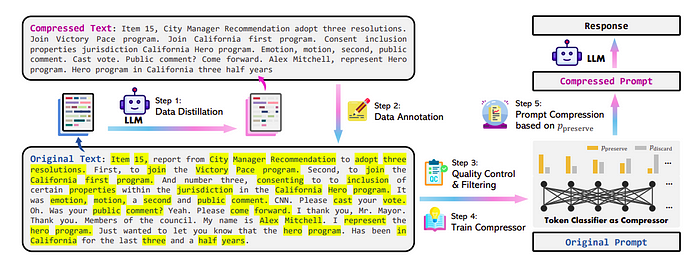Papers Explained 138: LLMLingua-2

LLMLingua-2 focuses on task-agnostic prompt compression for better generalizability and efficiency in LLMs. It proposes a data distillation procedure to derive knowledge from an LLM to compress prompts without losing crucial information, and introduces an extractive text compression dataset.
It formulates prompt compression as a token classification problem to guarantee the faithfulness of the compressed prompt to the original one, and use a Transformer encoder to capture all essential information for prompt compression from the full bidirectional context.
The project is available at llmlingua.com.
Recommended Reading [Papers Explained 136: LLMLingua] [Papers Explained 137: LongLLMLingua]

Dataset Construction
Data Distillation
The goal is to prompt GPT4 to generate compressed texts from original texts, while maintaining Informativeness and Faithfulness. However, distilling such data from GPT-4 is challenging, as GPT-4 tends to modify expressions used in the original texts and sometimes generates hallucinated content. To address this challenge, the following dataset distillation procedure is proposed.

GPT4 is explicitly instructed to compress the text s short as possible while retaining as much information as possible by discarding unimportant words in the original texts only and not adding any new words during generation.

GPT-4 tends to apply a high compression ratio when processing very long context, which might be due to GPT-4’s limited ability to handle long context. This aggressive compression leads to substantial information loss, significantly impacting the performance of downstream tasks.
To mitigate this issue, each long context is first segmented into multiple chunks, each containing no more than 512 tokens and ending with a period. GPT-4 is then instructed to compress each chunk individually.
Data Annotation
Having obtained pairs of original texts and their compressed versions from data distillation, the goal of data annotation is to assign a binary label to each token in the original texts to determine if it should be preserved or discarded after compression.

The following challenges are encountered in data annotation:
- Ambiguity: a word in the compressed texts may appear multiple times in the original content.
- Variation: GPT-4 may modify the original words in tense, plural form, etc. during compression.
- Reordering: The order of words may be changed after compression.
Alg. 1 outlines the overall procedure of the proposed annotation algorithm designed to deal with these obstacles.

Quality Control
The two quality control metrics are introduced for assessing the quality of the compressed texts generated by GPT-4 distillation.
Variation Rate (VR): This metric measures the proportion of words in the compressed text that are absent in the original text.

A high VR indicates that many words in the compressed text were not present in the original text, suggesting that the compression may have introduced new content or failed to follow the instructions properly. To ensure quality, examples with the top 5% highest variation rates are filtered out.
Alignment Gap (AG): This metric is calculated by first defining a matching rate (MR) and a hitting rate (HR) as a regularization term to measure the proportion of words in S_comp that are found in S_ori.


The Alignment Gap (AG) is then defined as (AG = HR — MR).
A perfect annotation would have an AG of 0. A large AG indicates a high hitting rate but a poor matching rate, implying low-quality annotation for the example. Therefore, examples with the highest 10% alignment gap are discarded to ensure dataset quality.
Compressor
A Transformer encoder based token classification model is trained on the dataset constructed from MeetingBank. During inference, it is determined whether to preserve or discard each token in the original prompt based on its probability calculated by the model.
First, the target number of tokens to be preserved in the compressed prompt x˜ is derived: N˜ = τN. Next, the probability pi of each word xi being labeled as preserve is predicted using the token classification model. Finally, the top N˜ words in the original prompt x with the highest pi are retained and their original order is maintained to form the compressed prompt x˜.
Specifically, xlm-roberta-large and multilingual-BERT are used for feature encoding in the compressor models, named as LLMLingua-2 and LLMLingua-2-small, respectively.
Evaluation
Datasets & Evaluation Metrics:
- In-Domain: MeetingBank dataset for training and testing, with additional QA tasks.
- Out-of-Domain: LongBench and ZeroSCROLLS for long-context scenarios, GSM8K and Big Bench Hard for reasoning and in-context learning.
Baselines: Compares against Selective-Context and LLMLingua, both based on LLaMA-2–7B, and other task-aware compression methods.
In-Domain Benchmark Performance
Evaluation of the performance of the proposed compression methods against baselines using the MeetingBank dataset.

LLMLingua-2 models outperform baselines in QA and summarization tasks, demonstrating effective dataset utilization and compression model optimization.
Out-Domain Benchmark Performance
Assessment the generalization ability of the proposed models on LongBench, ZeroSCROLLS, GSM8K, and BBH.


The models exhibit superior performance to task-agnostic baselines and comparable results to the original prompt, indicating good generalizability.
Performance with Mistral-7B as Target LLM

LLMLingua-2 shows significant performance gains over baselines, suggesting effective prompt compression for different LLMs.
Latency Evaluation

LLMLingua-2 achieves significant speedup and reduces GPU memory costs, highlighting its efficiency.
Out-of-Domain Evaluation with Expanded Dataset

Shows improved performance on general long-context benchmarks, indicating the benefits of dataset expansion.
Paper
LLMLingua-2: Data Distillation for Efficient and Faithful Task-Agnostic Prompt Compression 2403.12968
Recommended Reading [LLM Lingua Series]
Hungry for more insights?
Don’t miss out on exploring other fascinating threads in this series. Simply click here and uncover the state-of-the-art research!
Do Subscribe for weekly updates!!
